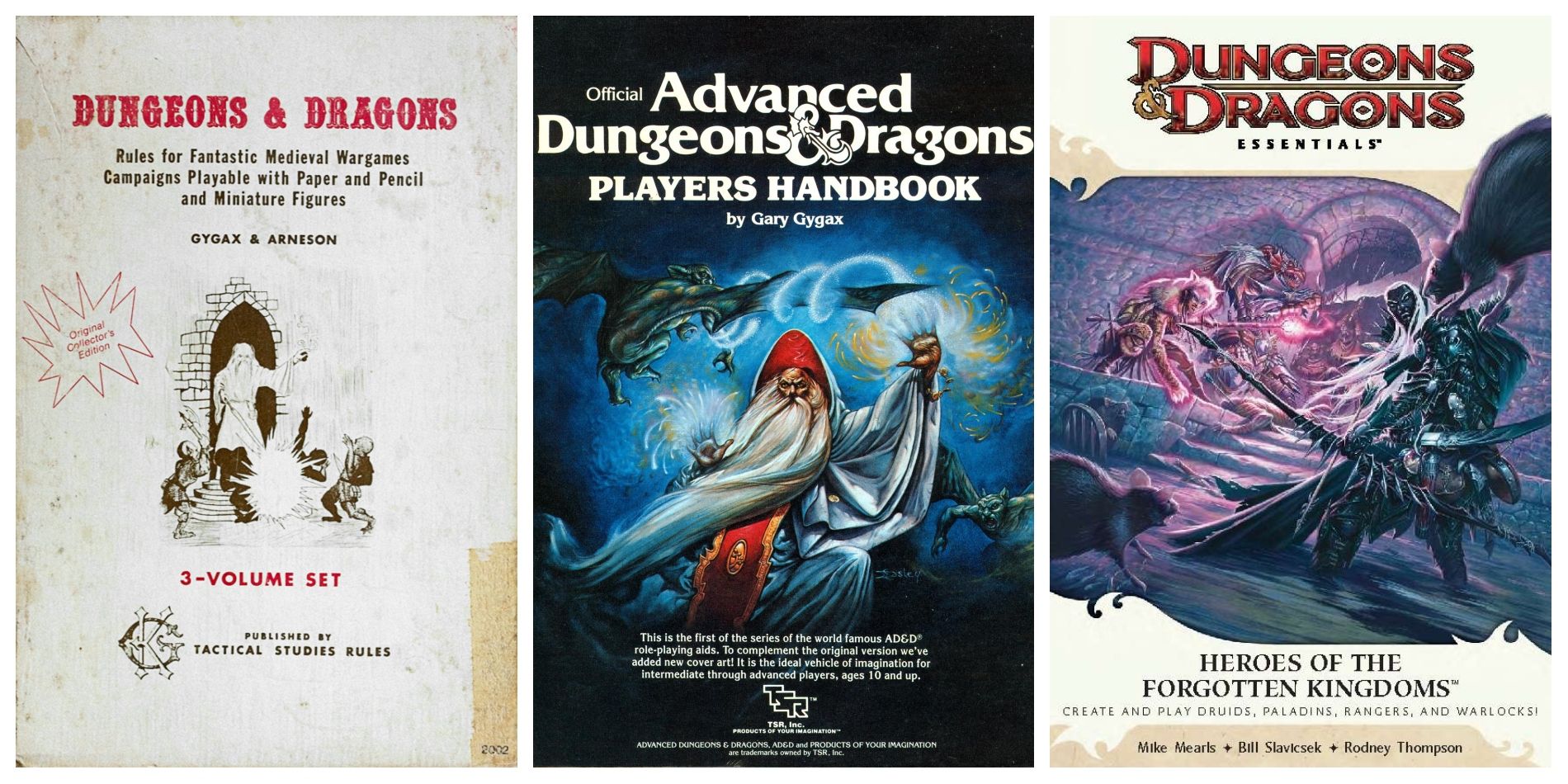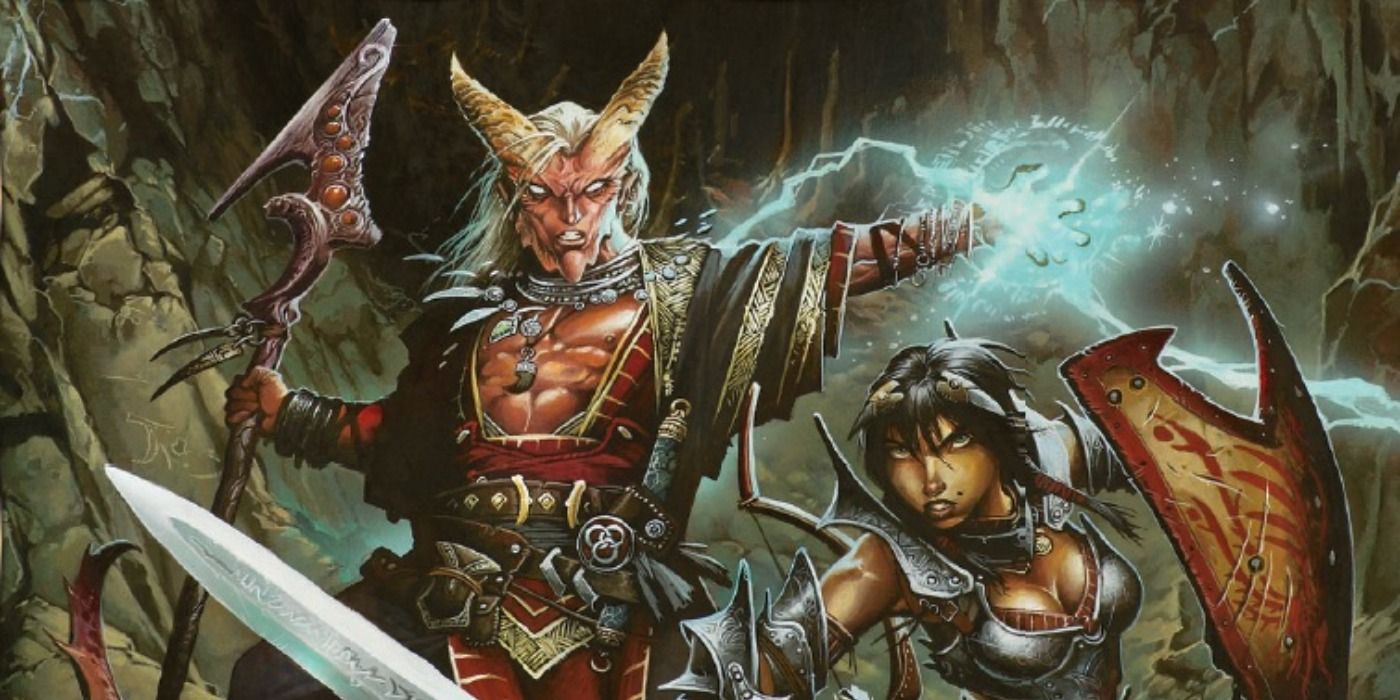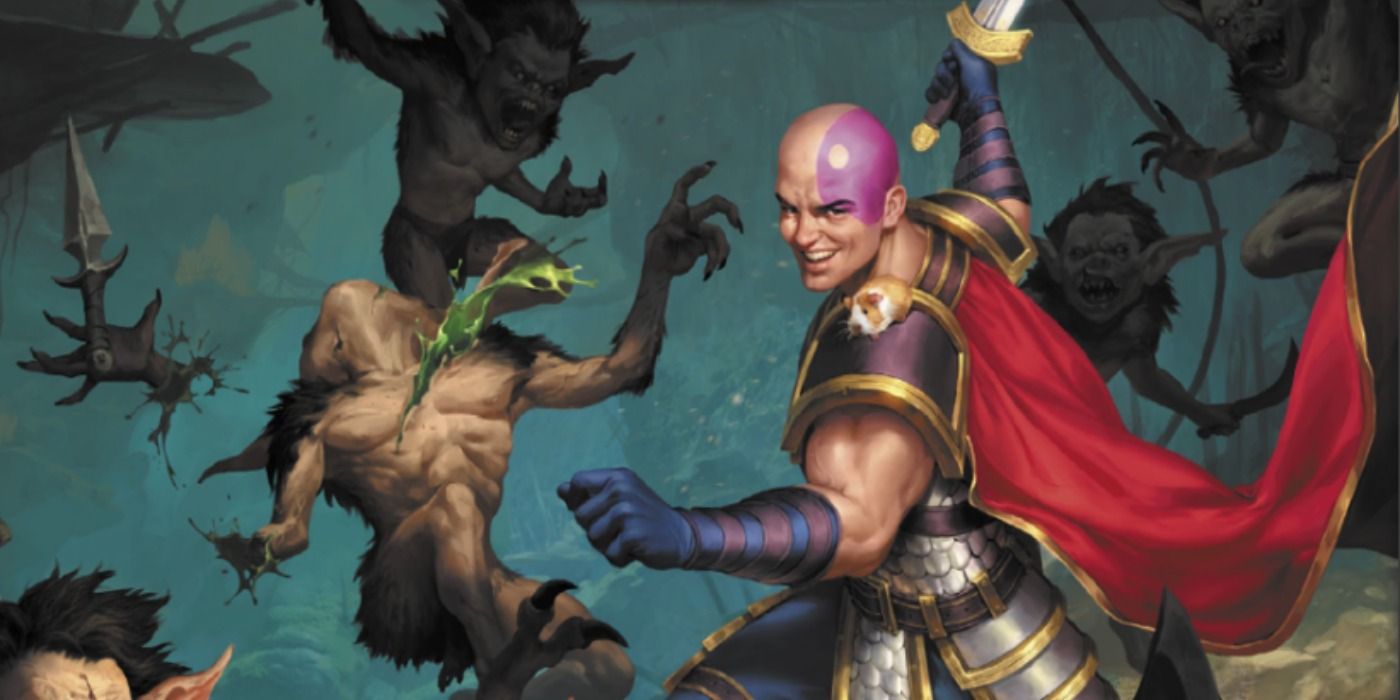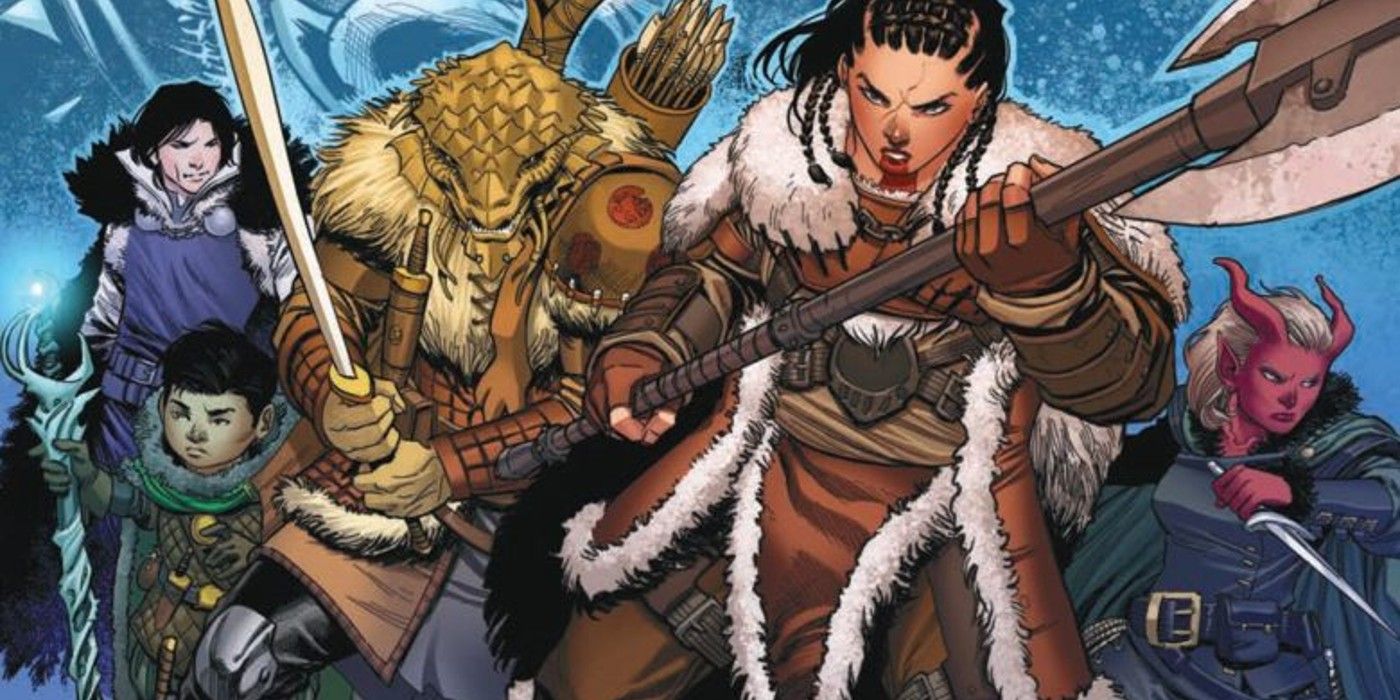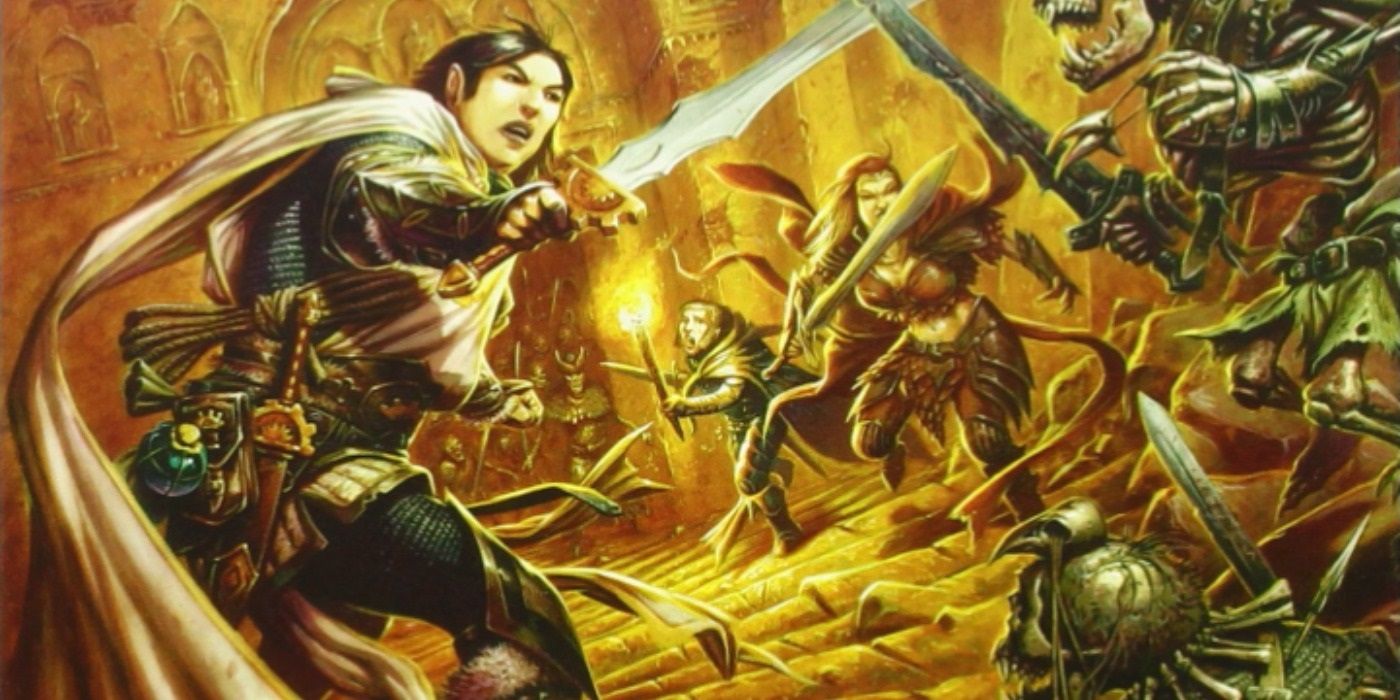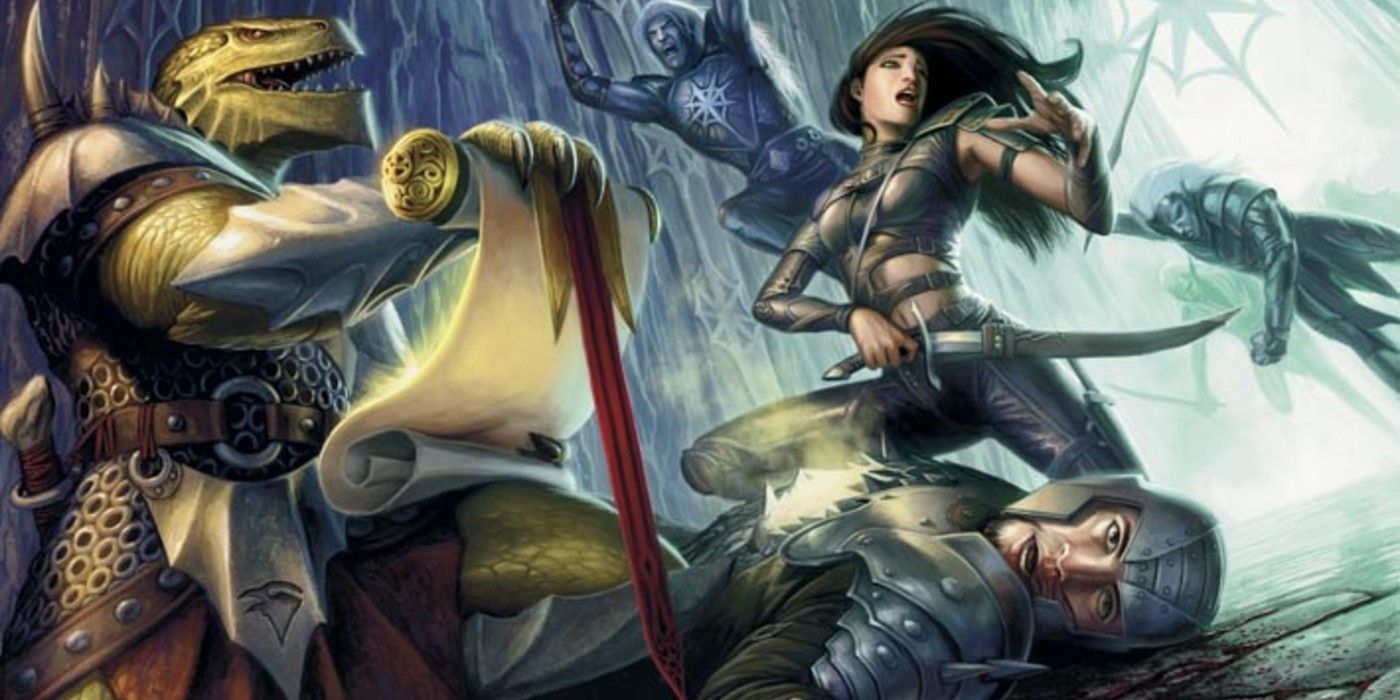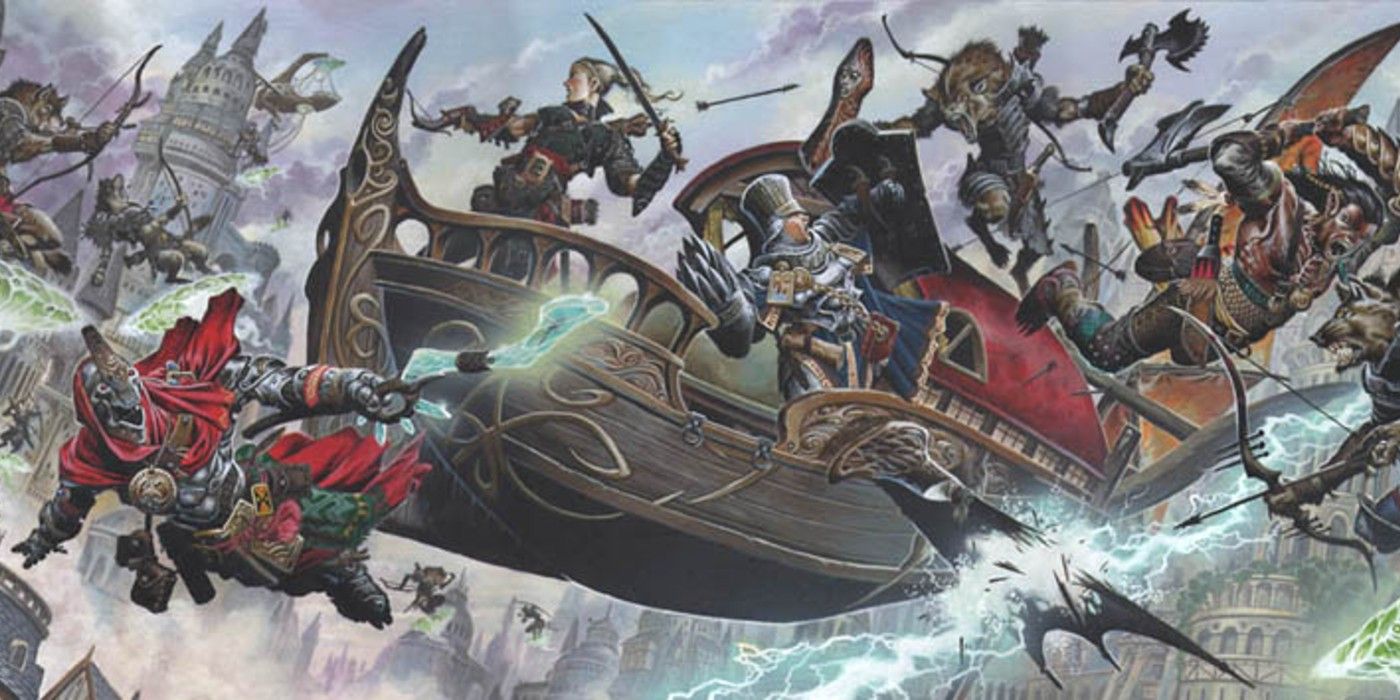The world’s best-known tabletop RPG, Dungeons & Dragons, is approaching its 50th anniversary. The game has undergone numerous rules revisions, and each successive edition has built upon the last in new ways. Coinciding with the game’s Gold Anniversary, D&D will be receiving new rulebooks in 2024, dubbed D&D edition 5.5 by some fans. The history of D&D’s rules shows just how far the game has come already. Those who have played numerous prior iterations, and new fans alike, can benefit from reviewing the history of each edition of Dungeons & Dragons.
Though D&D is officially on its fifth edition, there have been more than five versions of the game. This is partially due to the separation of Advanced Dungeons & Dragons from “basic” D&D, and mid-edition revisions. The earliest versions of D&D date back to 1974 and are generally now referred to as “Original Dungeons & Dragons,” or OD&D, by fans. D&D began as a derivative of a 1971 miniatures-based wargame called Chainmail. The shift in focus to controlling a single character, rather than acting as the general of an army, proved compelling enough to establish tabletop RPGs as a hobby that has stood the test of time.
The most seasoned fans of D&D may recall that OD&D had many printings and variants in its own time. Rules versions produced by the likes of Tom Moldvay and Frank Mentzer are considered their own distinct editions by some D&D veterans. These variants have enough common ground to still summarize as a single edition of the game, and note some of its characteristics, however. These formative versions of D&D did not present the game in a complete form. Rather, the lean, paperback digests of Original D&D provided a few levels' worth of player content, with the expectation that once they reached a certain level, they would purchase the next volume to advance. In some variants of OD&D, the D&D Basic book covered levels 1-3, the D&D Expert Set added levels 4-14, and the D&D Companion Supplement took the game to its maximum level of 36.
Original & Basic D&D Had Only Law/Chaos, Not Good/Evil, In Their Alignment Axis
Some iconic characteristics of D&D were very different in its original form. The well-known D&D alignment system, which now combines the axis of good and evil as well as law and chaos, originally featured only three alignments, Lawful, Chaotic, and Neutral. While it was noted that Chaotic actions are more commonly equated with Evil and Lawful actions with Good, there was no direct mechanical representation of Good and Evil. This was an evident homage to the works of fantasy author Michael Moorcock, whose works focused on the eternal struggle between Law and Chaos as an alternative to the morally black-and-white fantasy that had been more commonplace.
Along with the alignment change, Clerics were different in original D&D as well. Rather than worshipping a D&D deity or a pantheon, Clerics’ powers came from their conviction for their alignment and what it stood for. The Mentzer version of D&D went so far as to note, “In D&D games, as in real life, people have ethical and theological beliefs. This game does not deal with those beliefs… They can be assumed… and should not become part of the game.” This stands in contrast to modern D&D, where every campaign setting has a list of deities from which clerics can draw their power.
The distinction of race and class in D&D was another major difference for the game's earliest editions. Where the familiar character creation process, today, includes selecting a race and a class, in OD&D players selected a race or a class. Humans selected a class such as Cleric, Fighter, Thief, or Magic-User, while Elf, Dwarf, and Halfling, were essentially their own "classes." Dwarves functioned similar to Fighters, with added resistances, Halflings had characteristics of Fighter and Thief, and Elves were a blend of Magic-User and Fighter.
Advanced D&D Allowed Demi-Humans To Select A Class, Like Human Characters
Original D&D was followed by a split, where two versions of the game were supported concurrently for many years. The rules of OD&D were maintained in the Basic D&D line, which featured several revisions of its own, including a Rules Cyclopedia that collected the rules for all 36 levels of play in a single, core book. Advanced Dungeons & Dragons sold alongside Basic D&D, and AD&D introduced many of the familiar rule elements fans recognize today, while also beginning the edition “numbering” that has carried forward to current 5e D&D. Non-human races were no longer their own classes, and could select classes like humans, though these “demi-human” characters often had class restrictions as well as level caps, unlike human characters.
Demi-humans had a unique option to “multiclass” in AD&D, which was handled differently than multiclassing in modern D&D. Only demi-human characters could multiclass, and this meant they would start as more than one class and advance in those classes concurrently. A Half-Orc could play a Cleric/Assassin, dividing their experience points between the two classes until they hit the level cap for their race, where an Elf or Half-Elf could elect for a three-way split with Fighter/Magic-User/Thief. Humans had a different option, later dubbed “dual classing,” where they would advance to a certain level in a single class, then begin at level one in a different class while retaining the features gained by the original.
Advanced Dungeons & Dragons introduced the nine-point alignment system used today, where alignment combines a choice along the axis of good and evil as well as law and chaos, with true neutral as the ultimate middle ground. A Cleric's divine power came from deities rather than broad philosophical concepts. Some rule elements that OD&D, and Basic D&D, kept largely to the Dungeon Master’s side of things, were made more transparent for players, including scaling accuracy with weapon attacks and improved Saving Throws with level advancement.
Second Edition AD&D Featured Numerous Sub-Systems Lacking Unified Mechanics
The second edition of Advanced Dungeons & Dragons did not stray far from the first AD&D. Some rules were changed, and many new optional rules added, including a plethora of “kits” for classes that would exchange some features for specializing elsewhere, like the Berserker Fighter or the Bounty Hunter thief. These kits were spread across numerous sourcebooks, including major rules expansions like Skills and Power and Combat and Tactics, as well as campaign settings and class specific supplements. The Half-Orc race and the D&D Monk Class, both part of the core Player’s Handbook of Advanced D&D’s first edition were removed from the core book for the second edition.
The second Edition of AD&D retained the design paradigm of 1e AD&D, where the game lacked a unified system. D&D's Thief abilities functioned based on a percentile chance, attack rolls and saving throws required rolling high on a d20, and combat initiative involved rolling low on a d10. Each class had a different experience table, leading to some characters leveling faster than others, and many classes stopped gaining hit dice after a certain level, instead gaining a fixed bonus such as +2 per level beyond that point. The list of saving throws was complex, and often ambiguous as to which would apply, as there were separate saves for “spells” and “death magic.” AD&D Clerics and Wizard builds advanced in spell levels at different rates, and the Psionics system used a different progression method altogether.
AD&D and its second edition, therefore, had a unique personality, but the rules were anything but simple, as the game essentially mashed numerous disparate rule systems into one game. With third edition D&D, the game dropped the “Advanced” from the name and created a streamlined take on Dungeons & Dragons that had a lasting impact on the game, and tabletop RPGs in general. 3e D&D introduced the “d20 System,” a unified mechanic where nearly all checks are resolved by rolling high on a twenty-sided die. Thief-skills based on percentile-based checks were removed, and a unified D&D skill system was added wherein any class could take ranks in skills like Move Silently and Climb. The addition of social skills like Diplomacy and Gather Information gave clearer mechanics to social encounters than the “reaction modifiers” of Advanced D&D. All classes had a shared experience chart, thus would level equally, and any race could select any class, without level limits.
3e D&D Introduced The D20 System That Streamlined The Game And Changed Tabletop RPGs
Third edition D&D removed the old multi-classing and dual-classing rules, introducing a new type of multi-classing that distinguished character level from class level, an approach 5e D&D has mirrored. A character could take three D&D Fighter levels and then a Wizard level, making them a Fighter 3/Wizard 1, but a level 4 character overall, meaning their next level would require the same amount of experience as a pure Fighter going from Fighter 4 to Fighter 5. Character-level based advancement was introduced as well, including Feats and boosts to base ability scores.
Many other elements were unified in 3e D&D, as Clerics, Wizards, and other “full spellcasters” advanced at the same progression from spell levels 1 to 9. The kits of 2e AD&D were replaced by “prestige classes,” specialized classes that had specific requirements of feats, skills, proficiencies, or other abilities, to qualify for. The list of saving throws was paired down to three in 3e D&D, Fortitude, Reflex, and Will, abandoning overly specific types such as “Breath Weapon.” Although 3e D&D was complex, coming off the numerous incongruous systems of 2e AD&D, it seemed remarkably streamlined in comparison. The introduction of a shared skill system for all classes, and a universal mechanic of high rolls on a d20, have remained in every iteration of D&D that followed.
With 4e D&D, the game saw a drastic departure from some of the rules that D&D had maintained since OD&D. As a result, D&D’s fourth edition provided arguably the richest and most rewarding system for tactical fantasy combat ever created for a tabletop RPG, but for some players, the changes were too much. The game’s mechanics were more unified than ever, as each class gained “powers” in an identical progression. These were divided between At Will, Encounter, and Daily abilities, a new concept for the game, as spells and special abilities previously tended to have a specific number of uses per day in earlier editions.
4e Acknowledged Character Roles, Tiers Of Play, And Further Unified D&D's Rules
The concept of “roles” was introduced to the mechanics, a notion that was already present at many tables when discussing party balance in prior editions, now codified in 4e D&D’s rules. Strikers were built for high single-target damage, typically. D&D 4e's Defenders, acted as the group’s tank, punishing enemies who target weaker party members. Leaders were the healers, also offering a variety of buffs and additional attacks in some cases. Controllers focused on debuffs and area-effect damage, particularly useful for slaying “minion” enemies, a new monster type with 1 Hit Point. These four roles covered a variety of classes, as Defenders include the iconic Fighter as well as the teleporting Swordmage, and leaders could be a Cleric healing with divine intervention, or a Warlord providing the same through martial inspiration.
The same three saving throws from 3e D&D were maintained in 4e, with the unique twist that they were no longer rolled by the defender. Fortitude, Reflex, and Will were instead Defenses, like Armor Class, and attacks could be made against any of these four defenses, depending on the power in question. Multiclassing against shifted in D&D 4e, as characters could no longer freely change classes with each level but could instead take feats to learn powers from a different class list. With enough multi-class feats earned, a character could “Paragon Multiclass” in lieu of selecting a Paragon Path, the 4e D&D answer to Kits and Prestige Classes. 4e D&D also officially acknowledged the tiers of play, and extended the level limit from 20, the cap in AD&D 1e through 3e D&D, to 30. The first ten levels were dubbed the “Heroic Tier,” 11-20 the “Paragon Tier,” and the final ten levels as the “Epic Tier.” 4e D&D also introduced the idea of a “short rest,” a five-minute break where the heroes can catch their breath, recharging Encounter powers in the process, and self-healing through expending Healing Surges, if needed.
With 5e D&D, its current edition, and the most financially successful version of D&D with its best year ever in 2020, the designers essentially married elements of 3e and 4e D&D, along with the simplest rule set the game has ever seen. The scaling inherent attack bonuses of older editions that would raise to as high as 15 or 20, and the skill systems which saw similar number spikes, were replaced by a universal “proficiency” system scaling from +2 to +6, which applies for any check a character is proficient in, including attacks, skill checks, and tool usage. Creating a character became a simple matter of applying a race, a class, and a background, to determine all of a hero’s starting proficiencies.
Current 5e D&D Borrows From Every Prior Edition, Including Strange Nods To Early D&D
The design of 5e includes some unexpected choices, as the D&D Feat choices and ability score bonuses of 3e and 4e were replaced by levels where a character selects between a Feat or an attribute bonus. These levels were tied into class progression, rather than overall character level, as with 3e D&D. The spine of the game returned to the 3e D&D paradigm, with characters able to freely multi-class every level, assuming attribute thresholds are met. The three saving throw types of 3e and 4e D&D were abandoned, and now every one of the six base ability scores carries its own saving throw, rolled by the defender.
Current 5e D&D also features some throwbacks to Advanced Dungeons & Dragons. In AD&D and its 2e version, there were magic items that would “replace” a base stat, such as a Belt of Giant strength. In 3e these were changed to items that add a set number to a base stat to reward players who invested in the necessary stats for their class, rather than “dumping” that stat in the hope of replacing it with a magic item, and 4e did away with stat-altering items altogether. 5e D&D bizarrely brought back the stat “replacement” magic items, an element that provides an old-school vibe, but remains a questionable design choice. As a successor to Kits, Prestige Classes, and Paragon Paths, every D&D class now selects a sub-class, providing it specialization and uniqueness.
The Healing Surges of 4e were renamed Hit Dice with 5e, but the D&D Short Rest mechanic remained, although the time required was extended to one hour, making short rests difficult in high-tension, time-sensitive scenarios. Thanks to abilities that recharge with Short Rests as well as others needing Long Rests, the At Will/Encounter/Daily powers of 4e remain in 5e D&D, in a sense, alongside the spellcasting system based on a number of prepared spells per day used in 3e D&D and earlier versions. Unlike 4e, these are not “unified” in 5e D&D classes. Fighter abilities like Action Surge recharge with short rests, while Barbarians have a set number of Rage uses per day. This leads to a scenario where some classes rarely benefit from a short rest, while others require them to function properly.
The Future Of D&D Holds Limitless Possibilities, Influenced By Decades Of Gaming History
The design of 5e D&D may seem quirky to some longtime fans, as it lacks the options afforded by 3e D&D as well as the clarity of purpose of 4e D&D. What 5e D&D excels at more than any other, including the earliest versions of OD&D, is that it is easy to learn. The core concepts are intuitive, the numbers are smaller and less intimidating, and the “bounded-accuracy” design ensures an enemy is rarely impossible to deal with, even for less optimized characters. The game is, in a sense, a grab-bag of elements from throughout the prior 40 years of D&D’s history. While not every element works, it has proven popular, perhaps by finding the sweet spot between nostalgia, functionality, and ease of access. Each edition of Dungeons & Dragons has added something new that inspired the current 5e rules, and with the 5.5 D&D revision coming in 2024, another chapter will unfold in the ever-evolving rules of the world’s oldest tabletop RPG.

